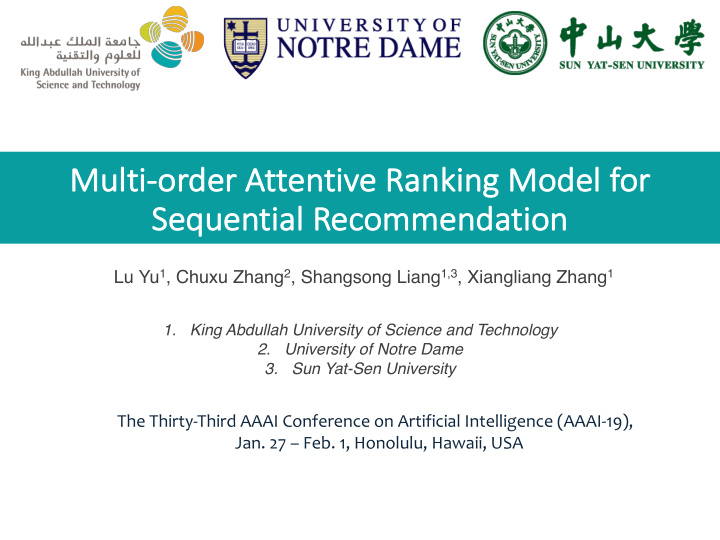



Mu Multi-order Attentive Ranki king Model fo for Se Sequential Recommendation Lu Yu 1 , Chuxu Zhang 2 , Shangsong Liang 1,3 , Xiangliang Zhang 1 1. King Abdullah University of Science and Technology 2. University of Notre Dame 3. Sun Yat-Sen University The Thirty-Third AAAI Conference on Artificial Intelligence (AAAI-19), Jan. 27 – Feb. 1, Honolulu, Hawaii, USA
Goal: Understanding Dynamic User Behaviors for Next-step Prediction E.g. Predicting what users are going to buy next. Transaction History from previous time to present Long-term Preference Session Behavior General Recommender MARank Session-based Recommender
Goal: Understanding Dynamic User Behaviors for Next-step Prediction Augmenting User Preference with Item-item Transition.
Markov-chain Models VS Deep Network for Sequence Modeling Modeling Markov-chain Transition Probability Previous Interacted Items Model Parameters
Markov-chain Models VS Deep Network for Sequence Modeling Factorizing Personalized Markov Chains (FPMC) Only Modeling Individual-level Interaction Steffen Rendle et al., Factorizing personalized Markov chains for next-basket recommendation. In WWW '10
Markov-chain Models VS Deep Network for Sequence Modeling Translation-based Recommendation (TranRec) Only Modeling Individual-level Interaction Ruining He et al., Translation-based Recommendation. In RecSys ‘17
Markov-chain Models VS Deep Network for Sequence Modeling Gated Recurrent Neural Network for Recommendation Union-level Interaction Bala ́zs Hidasi et al., Session-based Recommendations with Recurrent Neural Networks. In ICLR ‘16
Markov-chain Models VS Deep Network for Sequence Modeling Convolution Sequence Embedding Both Individual- and Union-level Interaction Temporal-Spatial Aggregation, Fails to Personalization Jiaxi Tang et al., Personalized Top-N Sequential Recommendation via Convolutional Sequence Embedding. In WSDM ‘18
Markov-chain Models VS Deep Network for Sequence Modeling Our Solution: Multi-order Attention Model Residual Connection Individual-level Residual Net Union-level Overall Architecture Multi-order Attention Network Lu Yu et al., Multi-order Attentive Ranking Model for Sequential Recommendation. In AAAI ‘19
Experimental Analysis – Overall Comparisons RQ1: Can our proposed method outperform the state-of-the-art baselines for sequential recommendation task? RQ2: How does data sparsity influence MARank? RQ3: How MARank is affected by each component? http://jmcauley.ucsd.edu/data/amazon/ https://www.yelp.com/dataset/challenge
Experimental Analysis – Overall Comparisons Table 2: Ranking performance comparison (the best results of baseline are marked as * along with underline). The last row shows the improvement of MARank over the best baseline algorithm.
Experimental Analysis – Overall Comparisons
Experimental Analysis – Sparsity
Experimental Analysis – Sparsity
Experimental Analysis – Components
Question & Answer Thank You Contact Info: {lu.yu, xiangliang.zhang}@kaust.edu.sa Lab Page: https://mine.kaust.edu.sa Code Page: https://github.com/voladorlu/MARank
Recommend
More recommend